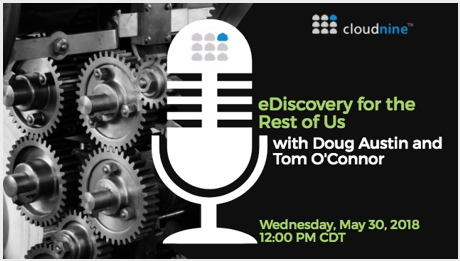The Price is Right. Or is it? You Be the Judge: eDiscovery Trends
Talking about eDiscovery pricing in this industry is like talking about Fight Club, the first rule and second rule seems to be that you don’t talk about it. Only Rob Robinson could get 81 people to talk about what isn’t talked about in this industry.
But, before I talk about it, I must first issue a “mea culpa”. Every post for this blog is posted by me (even if not written by me) and I always schedule the posts to hit right after midnight on the day they will be posted. On Sunday, I wrote the post for Monday and I selected the date and time for the post to issue. But I forgot to hit the schedule button!! Doh!! So, the post didn’t hit our blog site until I noticed it about mid-morning and the daily newsletter wasn’t issued because there wasn’t a new post at “press time”. Honestly, I’m surprised it hasn’t happened before.
So, if you missed yesterday’s post about my guest post for our good friends and Kansas City partners at Complete Legal regarding Leveraging Your Services Provider to Meet Today’s eDiscovery Challenges, click here to see it referenced on our blog. Or better yet, click here to go straight to that guest post. My bad.
Regardless, this post is about the latest survey from Rob Robinson and his terrific Complex Discovery blog. The eDiscovery Pricing Survey is a non-scientific and non-comprehensive survey designed to provide general insight into eDiscovery pricing as shared by individuals working in the eDiscovery ecosystem. It consists of 15 multiple choice questions focused on information and metrics related to eDiscovery pricing for collection, processing, and review tasks and it is open to legal, business, security, and information technology professionals operating in the eDiscovery ecosystem. Individuals are invited to participate semi-annually primarily by direct email invitation from Complex Discovery and leading industry educational partners including the Association of Certified E-Discovery Specialists (ACEDS).
As I mentioned, there were 81 respondents for this Summer survey – 84% of which were providers (Software and/or Services Provider – 38.3%, Law Firm – 32.1% and Consultancy – 13.6%). That’s 68 providers talking about eDiscovery pricing! :–O
I won’t steal Rob’s thunder in this blog, check out the survey results here. This is the second eDiscovery pricing survey published by Rob – check out the first survey here.
So, what do you think? How do those results compare with what you pay for eDiscovery services? Please share any comments you might have or if you’d like to know more about a particular topic.

Sponsor: This blog is sponsored by CloudNine, which is a data and legal discovery technology company with proven expertise in simplifying and automating the discovery of data for audits, investigations, and litigation. Used by legal and business customers worldwide including more than 50 of the top 250 Am Law firms and many of the world’s leading corporations, CloudNine’s eDiscovery automation software and services help customers gain insight and intelligence on electronic data.
Disclaimer: The views represented herein are exclusively the views of the author, and do not necessarily represent the views held by CloudNine. eDiscovery Daily is made available by CloudNine solely for educational purposes to provide general information about general eDiscovery principles and not to provide specific legal advice applicable to any particular circumstance. eDiscovery Daily should not be used as a substitute for competent legal advice from a lawyer you have retained and who has agreed to represent you.










